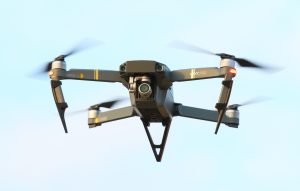The Diplomat author Mercy Kuo regularly engages subject-matter experts, policy practitioners, and strategic thinkers across the globe for their diverse insights into U.S. Asia policy. This conversation with Alexandra Seymour, an associate fellow at the Technology and National Security Program, Center for a New American Security in Washington, D.C., is the 344th in “The Trans-Pacific View Insight Series.”
Explain the policy relevance of the U.S. Department of Defense’s decision to blacklist Chinese drone maker DJI.
The U.S. Department of Defense (DoD) and the broader U.S. national security community has acknowledged the risks posed by DJI for several years, prompting actions that have included adding DJI to the Entity List in 2020 and to the investment blacklist in December 2021 for surveilling Uyghurs in Xinjiang.
However, the DoD’s decision to blacklist DJI is a new recognition for policymakers, whose decisions have largely focused on humanitarian concerns about surveillance. DJI is now considered a “Chinese military company,” meaning its technologies are designed in a way that can support the People’s Liberation Army (PLA)’s objectives. The undeniable presence of DJI drones in the Russia-Ukraine war, as illustrated by video evidence on Twitter, enabled the DoD to move forward with this designation. After Ukrainian troops called out DJI for contradicting their non-military stance, DJI decided in April to discontinue service in both Russia and Ukraine. Despite this action, Russian troops continue to rely on DJI drones to bolster their information advantage.
Consequently, by naming DJI in accordance with Section 1260H of the 2021 National Defense Authorization Act, DoD has rejected outright DJI’s continuous claims that its drones are only used for civilian purposes and is countering the PLA’s military-civil fusion strategy by addressing the company’s operations “directly or indirectly in the United States.”
What signal is DoD sending to U.S. consumers of DJI drones?
The national security concerns remain the same, which are primarily that DJI drones can be used to gain an information advantage. This includes their ability to gather data that can be transmitted back to the People’s Republic of China (PRC) to power artificial intelligence models, enhance surveillance efforts, or inform targeting of critical infrastructure. As a result, by acknowledging DJI’s contributions to the PLA’s military-civil fusion strategy, the DoD is warning consumers that even seemingly harmless civilian-use cases of DJI drones can be contributing to PLA military activities and modernization.
Moreover, by signaling to U.S. consumers that their DJI drones are not limited to commercial use, the DoD has added a new moral dimension for U.S. consumers. In addition to the confirmed links to Xinjiang that earned DJI a spot on the Entity List, U.S. consumers must ask themselves: Do they want to support a company that is contributing to the Russian fight against innocent Ukrainians? The answer to this is probably no, meaning that if DoD’s decision is communicated to the public widely and effectively, cost should become a less important factor than moral integrity in U.S. consumer decision-making for drone purchases.
Analyze the PLA-funding linkages to DJI.
The PRC approach of “military-civil fusion” draws no distinction between civilian and military sectors to achieve military aims, meaning direct PLA-funding linkages are not required to contribute to PLA activities. However, in the case of DJI, these linkages have been noted. Earlier this year, the Washington Post uncovered four previously unreported entities with ties to the Chinese government that have funded DJI, including a state asset manager committed to building partnerships that support the Chinese military. In addition to these links, DJI has cooperated with Chinese government demands to hand over data in the past, such as they did in 2016. These linkages should be enough to make policymakers and the public concerned about potential applications, and skeptical of DJI’s claims that it is a private company.
Examine the broader impact of DoD’s actions against DJI on the global drone industry.
Although this is another important step to reducing DJI’s influence, DJI still retains the majority of global market share. Given there are already restrictions in place for national security applications, additional restrictions geared towards the civilian sector are needed to see a significant impact on DJI’s footprint. At the same time, DoD’s action is a signal to allies and partners about the additional security concerns they should consider. With this action, there is a new opportunity to coordinate policies among like-minded countries that promote trusted drone development and use and to invest in alternatives.
Assess how DoD’s blacklisting of DJI reflects the Pentagon’s strategy to counter China’s civil-military fusion apparatus.
DoD’s blacklisting of DJI reflects its broader strategy to counter military-civil fusion by bolstering the connection between PRC civilian and military companies. Since the technology is consistent across sectors, and recognizing the PRC’s intentions to achieve technological superiority, this action calls for increased measures to protect information and infrastructure, which extends to the broader industrial base.

































